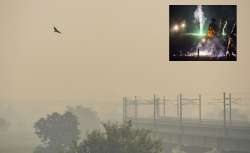Less crackers, strict enforcement result in 30 per cent reduction in air pollution on Diwali night: DPCC
The decline in emissions of dangerous PM10 and PM2.5 particles across Delhi ranged from 20 to 50 percent, indicating the air quality was better than previous years, DPCC said in a statement.

The Delhi Pollution Control Committee on Monday said less fireworks, rigorous night patrolling and enforcement measures to curb instigators reduced the PM2.5 and PM10 levels by 30 per cent on Diwali night this year when compared to 2018.
The decline in emissions of dangerous PM10 and PM2.5 particles across Delhi ranged from 20 to 50 percent, indicating the air quality was better than previous years, DPCC said in a statement.
Delhi Environment Minister Kailash Gahlot said the air quality post Diwali this year seems much better than what it was after the festival in 2018.
Interacting with reporters on the sidelines of an event here, Gahlot said people also say less crackers were used this year.
The autonomous regulatory body said the peak level of PM2.5 — tiny particulate matter equal to or less than 2.5 microns in diameter that can enter deep into the lungs and even the bloodstream — was 1,070 micrograms per cubic metre (µg/m3) at midnight.
Last year, it was 1,560 µg/m3 — a reduction of around 30 percent.
"The peak level of PM10, which was 1,859 µg/m3 on Diwali night last year, came down to 1,391 µg/m3 — again a drop of 30 percent," the DPCC said in a statement.
The concentration of sulphur dioxide and carbon monoxide was also within the acceptable levels at all stations this Diwali.
"As against the acceptable level of 80 µg/m3, the SO2 concentration remained between 1.76 (at Mandir Marg) and 41.48 (at Jahangirpuri) — much below the unsafe limit," it said.
"The significant drop of about 30 percent in PM2.5, SO2 and CO shows that people have burnt much less firecrackers this year and have contributed to the overall improvement," DPCC said.
ALSO READ | Delhi air quality turns 'very poor' post Diwali; respiratory problems, allergies on rise
ALSO READ | Haze envelops Delhi-NCR as revellers flout Supreme Court guidelines
